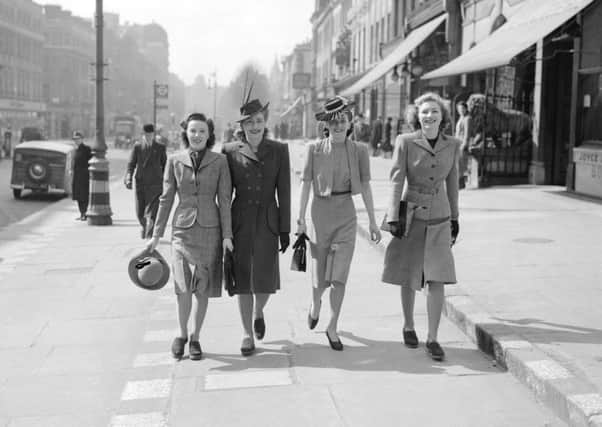Wartime fashion


And to mark the milestone, a new exhibition is taking a closer look at what this meant for the fashion industry and textile trade.
The display, on at the Imperial War Museum, reveals how these unexpected clothing regulations affected working class families.
Advertisement
Hide AdAdvertisement
Hide AdMuch of what is written about wartime dress focuses on how fashionable styles were influenced by the unprecedented way in which the government dictated how many clothes were permitted and what style those clothes should be.
Under the new restrictions, the purchase of clothing required everyone over the age of four to provide coupons.
At first, 66 coupons a year were issued, this soon dropped to 48 and, by 1945, 36 coupons a year were given to each adult.
Clothes rationing had more of an effect on the wardrobes of the middle classes, as opposed to their working class counterparts.
Advertisement
Hide AdAdvertisement
Hide AdWhen researching, Dr Alison Slater – who is a lecturer in design history at Manchester Metropolitan University’s School of Art – interviewed a woman who was nine years old in 1941 and living in Oldham. She described the introduction of clothing rationing as ‘a joke’.
She said: “When we knew clothes were being rationed and they told us what the allowance was, it was quite amazing because we thought: ‘Oh well, fancy that, is that supposed to be a ration’?”
Dr Slater said: “From our current perspective of easy access to ready-made clothing for a variety of budgets, it is hard for those of us without first hand experience to understand how limited the working-class wartime wardrobe was.
“An average woman in this social class might have one dress, one skirt, one blouse, one pair of shoes, one coat and two sets of underwear (one to wear and one to wash!). Garments were looked after to ensure they lasted as long as possible: hanging them up after wearing, brushing to remove visible dirt and laundering (by hand) when needed.”
Advertisement
Hide AdAdvertisement
Hide AdAs well as having coupons for clothes, families also needed money to purchase items. For those with limited incomes, managing the household – including clothing – was a constant struggle.
Purchases were prioritised according to what was needed, how long it would last and what was available; whether or not you liked something often came last, much to the dismay of those interested in a fashionable appearance! There were ways around the restrictions even for those with less money. If you worked in a mill or factory where cloth or garments where made, there might occasionally be off-cuts available.
There was a black market for material, although acquiring fabric in this way went against ideas of working class ‘respectability’.
Trousers are often thought of as being fashionable during this period, but research undertaken for the Advertising Service Guild in summer 1941 suggested that wearing trousers was considered ‘peculiar’ unless trousers were part of a work uniform.
Advertisement
Hide AdAdvertisement
Hide AdWhile it was not a common practice and was often frowned upon in traditional working class communities, some younger women wanted to wear trousers which they had seen in films and magazines.
Dr Slater continued: “One lady I interviewed, said: ‘Women didn’t wear trousers in those days but film stars did sometimes and I had this passion to wear trousers. During the air raids, we used to go to a communal shelter in the field behind our house.The shelters were very cold, so my mother bought us outfits to wear for the shelters and my sister had what she called a Siren Suit the sort of thing that Winston Churchill wore, it was a little zip-up suit. I was bought some navy blue trousers that I could wear to go into the shelter. I never wore them apart from going into the shelter, but I would have liked to have done’.”
The date of the introduction of clothing rationing – Whit Sunday – also gave an advantage to many.
A practice of getting new clothes for Whitsun had begun in the 19th century and meant that many had already got their annual purchase of new ‘best’ clothes for the year prior to rationing being introduced.
Advertisement
Hide AdAdvertisement
Hide AdBest clothing was often prioritised as it presented the all-important respectable appearance in public; after a period of time, these best clothes would then go down to everyday wear.
Parents had to sacrifice their clothing choices for those of their growing children.
Articles in Housewife magazine during the war said the appearance of children reflected their mother’s taste and also their father’s salary.
Many of the decisions around public appearance were made against the backdrop of worrying about how others would interpret one’s appearance in public.
Advertisement
Hide AdAdvertisement
Hide AdPerhaps this explains why coats were an important garment in the working-class woman’s wardrobe.
For underneath a coat a multitude of clothing sins, from insufficient clothing to heavily repaired items, could be hidden.
In June 1942, the Government Make Do and Mend campaign was launched, encouraging people to sacrifice the purchase of new clothing to allow the labour and raw materials to be used in the war effort.
Dr Slater said working class families had established practices that helped ensure their clothing lasted as long as possible.
Advertisement
Hide AdAdvertisement
Hide AdShe said: “For working class families, the mentality of mending and making do was continued from the pre-war, wartime and post-war era and through rationing enabled them to cope at a time when their wealthier counterparts experienced significant changes in their clothing practices.
“For many, the ethos of mending and making do lasted long after the war.”
She added: “In our age of fast fashion and the ethical issues that come with this, we could learn a few things from the wartime generation’s clothing practices.”